
Measuring and Increasing the ROI of Your Content Resources
The author's views are entirely their own (excluding the unlikely event of hypnosis) and may not always reflect the views of Moz.
Let me cut right to the chase. Do you want to know the value of your content marketing efforts? Want this report?
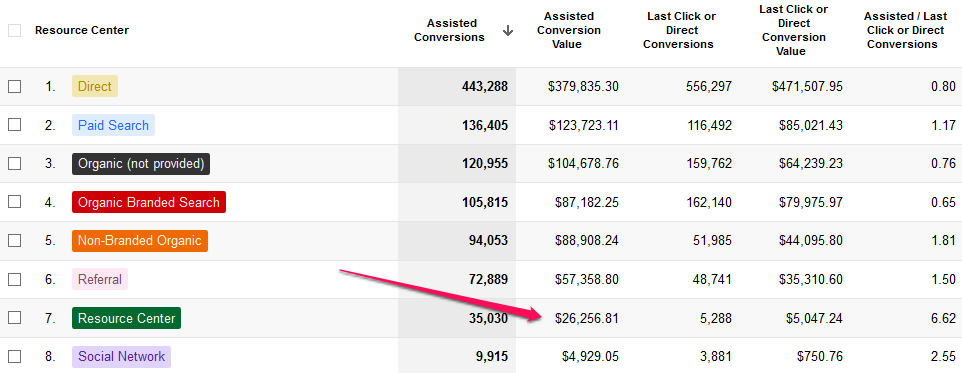
Read on and I'll tell ya!
Calculating the real ROI
With so much emphasis often put on the traffic generation potential of a good content marketing strategy, I want to focus this post on measuring and increasing the return on the (sometimes sneakily large) investment. Some common goals you'll hear surrounding a content marketing strategy include generating traffic for generic terms, increasing social shares, and developing your brand authority. In the right circumstances, all of these are nice metrics for the relevant stakeholders in the organization, but they're all just proxies for measuring the growth of a business. They're measurements of the means, not the end.
The impetus for a lot of what I'll be talking about in this post comes from Josh Braaten's post on the Google Analytics Blog a few months ago titled "How to Prove the Value of Content Marketing with Multi-Channel Funnels". Josh talks practically about how to measure the business impact of traffic that first experiences your site via a page that isn't directly selling a product or service to a consumer. Think: the "How to get into fly-fishing" article written by the outdoors retailer that sells fly-fishing poles, or even the "How to measure the effectiveness of content marketing" article written by the guy working for a company that's doing a two day kick-ass web marketing conference in Boston on May 20th & 21st :). Indeed, these content pages aren't selling a product or service, but they are selling the brand, the "purchase" made by the consumer is everlasting trust; and it has a really low conversion rate.
The necessary analysis for this gets difficult because it is so rare for a user to make the jump from discovery/informational stage to transactional stage in one sitting. Hence the need for multi-channel analysis: we need to take a conversion, look back at all of the interactions that have taken place leading up to that conversion, and assign some amount of credit to those channels that often show up toward the beginning of the conversion path. Social networks and the content that usually ranks for generic keywords are most often found in these early interactions. They are inherently 'openers' or 'exposers'.
So, now that we've covered the theory, let's look at measuring that ROI.
Expanding upon Josh Braaten's multi-content funnels
Everyone interested in what I've covered above should absolutely read Josh's post. In it, Josh walks you through how to create a report within Google Analytics' Multi-Channel Funnels that classifies users by the page type for which they first interacted (based upon landing page).

Custom channel creation is a lot like creating an advanced segment in GA
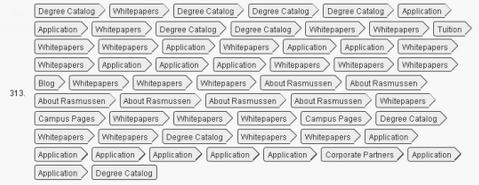
The top conversions path report - seen here displaying a pretty convoluted conversion path for one particular conversion.
I'm going to offer a slightly different direction, but they both accomplish the goal of getting value out of our visit data. Instead of comparing content sections against each other, let's instead compare it against our other channels like direct, referral, organic, and paid.
Let's do a step-by-step walkthrough
Head on down to the multi-channel funnels reports.
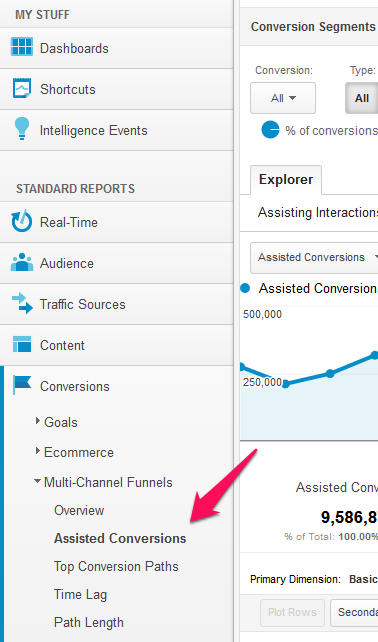
Make a copy of the basic channel grouping template.

Include traffic based on landing page URL. Hopefully you've got your resource center, blog, or content home on a neatly identifiable path in the URL. If you don't, you may have to go the route of declaring page-level custom variables.
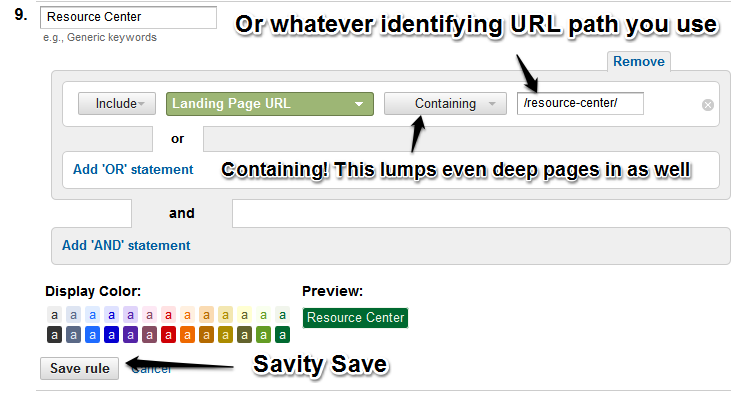
Drag it to the top. The order at which you put these channels is important because GA will go down the line until a match is found, then stop. If we leave our Resource Center channel at the bottom, the channels above will take a ton of visitors first because our rules aren't mutually exclusive.

Though not completely related to this topic, I'd also suggest separating your organic channel into branded, unbranded, and (not provided).

Because of that importance of ordering, if you put (not provided) first and branded second, the final organic group will necessarily consist of unbranded traffic.
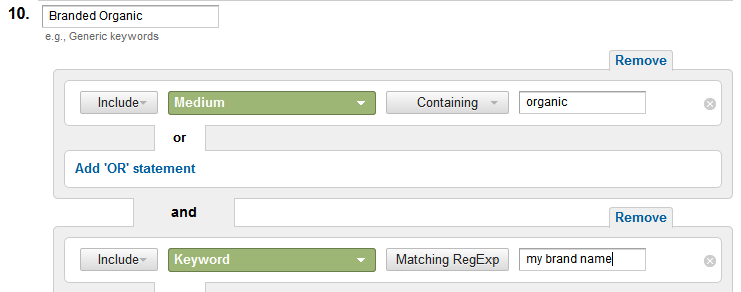
You can create this segment with a neatly crafted regex of your brand name and other branded terms.
Finally, let GA calculate things out, and voila!

What can we learn from the above?
Well, it should be pretty clear that under the traditional model of last click analysis, our resource center is under-valued. This much is obvious by the disparity in last click conversions and conversion value compared with assisted conversions and conversion value. Not only that, but the "Assisted/Last Click or Direct Conversions" ratio (6.62 in the screenshot) tells us that this content is acting in an assist role more than any other channel we have (the higher the number, the more likely it's an 'opener', not a 'closer' - those trend toward zero).
When we look at assisted conversion numbers, we CANNOT say that our resource center content is now directly responsible for $26k in revenue; that would not be quite fair using this model. But our content did have its hand in a lot more conversions than we may have originally assumed.
Now, as for this channel's relative contribution to the bottom line compared with other channels, well, yes, it's still a lot smaller. But consider that this particular website's resource center is actually quite small, especially compared with the size of the rest of the site. Knowing how many pages are in a resource center makes it pretty easy to apply simple math to determine what each new page is roughly worth. Or you could choose to do deeper analysis into specific pages or sections within. Again, I point to Josh Braaten's post for more on that.
But at the end of the day if you know that each new page added to the resource center has an assist in $X worth of conversions per year, justifying expansion becomes a lot easier.
A bonus tip for content marketers
So that was measuring the ROI of a content marketing strategy. But I've actually got a tip for increasing ROI that I'd like to share.
Our content strategies are targeted at the generic keywords that more often than not are queries that align with the user's information-seeking intent. If we had our way, the path would go like this:
Kitten mittens purchasing decision
A user searches "my cat's too noisy" and lands on your site's blog post "10 ways to deal with a noisy cat."
The user reads and is very happy with your content. In that content, you suggest "kitten mittens," a product that you sell.
The seed is planted in the user's mind, and upon deciding that they're ready to buy, the user either searches for your brand name, that post again, or the "kitten mittens" product, all of which lead back to your site.

Nightmare scenario time: what if they searched for "kitten mittens" and you don't rank for that term? Well, your content has done all the hard work, but your high-ranking competitor swoops in and gets the purchase. This must be corrected. But how?
Remarketing
It doesn't matter what remarketing tool you use (this would be super easy with GA's remarketing tool - here I wrote a post on it!), put the user above in a "noisy cat owner" list, and target them with "kitten mitten" ads around the web.
Thanks for reading, I hoped you learned something!
Let me know what you think in the comments or on Twitter, @MikeCP. Don't forget that Distilled is running our search marketing conference, SearchLove, in Boston on May 20th and 21st!




Comments
Please keep your comments TAGFEE by following the community etiquette
Comments are closed. Got a burning question? Head to our Q&A section to start a new conversation.